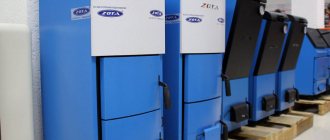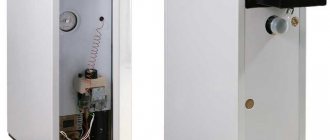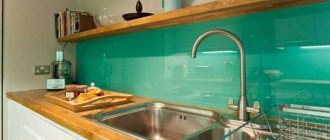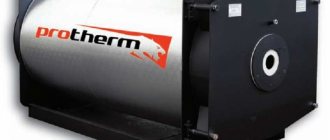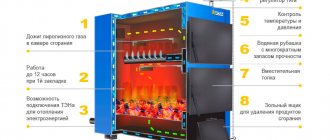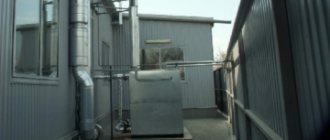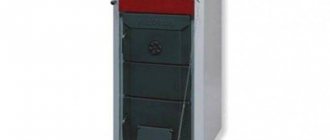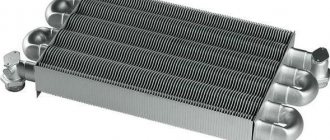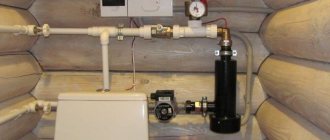The appearance on the market of solid fuel boilers with automatic feeding has greatly simplified the lives of many consumers for whom gas or electric heating is not available. The development of production has led to the creation of many models for various purposes. Knowledge about the structure, operating principles and types of automatic units will help you choose the most suitable and profitable option.
Features of boilers with automatic feed
The elements of the boiler installation, which are directly responsible for burning fuel and transferring heat to the home heating system, do not differ significantly from conventional solid fuel devices.
The main operational advantage of devices with automatic feeding is ensured by the presence of three basic components in their design:
- fuel bunker for one-time loading of large volumes of flammable materials;
- screw conveyor for regular transfer of fuel to the combustion chamber;
- complex automation responsible for the operation of the entire system.
The listed design elements provide the possibility of long-term combustion without additional maintenance of the boiler installation. To operate such equipment, human intervention is required no more than once every 1–2 weeks, and sometimes less often.
The automation also regulates the amount of fuel supplied, which depends on the current coolant temperature and the one set in the settings. When the bin is almost empty, the system notifies you to fill it.
Many models also feature the ability to automatically remove combustion products. That is, the entire process from ignition to cleaning in such units is carried out without human intervention.
Long burning boilers with hob from
In the assortment of this Russian manufacturer you can always find high-quality devices with great functionality and an impressive service life. Let us note some of the most interesting models:
- Cooper OVK-10. This compact, reliable and absolutely unpretentious model will be an excellent solution for heating rooms up to 90 m2. The device can be easily integrated into any heating systems and successfully performs the function of an additional stove. The water-tube heat exchanger provided in this model increases the heat removal surface and increases the efficiency of the classic water jacket. The Cooper OVK-10 boiler is equipped with a built-in 6 kW heating element unit, which continues to heat the coolant in the system even after the wood has completely burned out. Fuel can be loaded directly through the opening of the cast iron stove.
- Cooper OVK-18. This is a powerful heating boiler with a hob, designed for rooms up to 180 m2. The device is made of strong, durable and environmentally friendly materials. Thanks to the automatic draft control, the user can change the power of the heating system in the range from 30 to 100% of the maximum value. The built-in 6 kW heating element unit allows the boiler to continue heating the house even after the wood or coal has completely burned out. The package includes a thermometer, a rotary damper and accessories for cleaning the firebox and chimney. A convenient cast iron stove allows you to quickly and comfortably cook and heat any food.
The Teplodar line of boilers with a cast iron hob also includes interesting devices that run on gas:
- Cupper OVK-10 with gas burner AGG-13K;
- Cooper OVK-18 with gas burner AGG-26K.
These models have the same advantages as their solid fuel counterparts. If necessary, both of them can be easily converted to another type of raw material - to do this, you just need to purchase and install an additional burner. In addition, you can always switch the boiler to pellets - a modern environmentally friendly fuel that does not emit harmful gases and leaves a minimum of ash.
To buy a long-burning solid fuel boiler with a cast iron hob, contact the managers of the Teplodar online store in your region. You can also leave a request for a call back on our website - we will call you back at any time convenient for you. Our company’s specialists are always ready to advise you on the selection, installation and operation of heating systems.
Types of boilers by type of fuel bunker
There are two types of loading devices: built-in fuel hopper and mechanized storage. The battery life and the area occupied by the boiler installation depend on which of them the unit is equipped with.
Built-in fuel hopper
Models with a built-in loading device are equipped with a container for solid fuel, which is located on top or on the side of the main chamber of the boiler. The advantage of this design is the relative compactness of the heating installation. However, in terms of battery life, models with a built-in bunker are inferior to units with mechanized fuel storage.
Mechanized fuel storage
Here, a separate room or part of a room with a connected flammable material supply system acts as a loading device. The volume of such storage is enough to accommodate a year's supply of fuel.
The models are distinguished by a complex electronic automatic control system, which fully regulates all work processes, as well as the presence of a remote control unit.
Automatic fuel supply methods
Based on the methods of fuel supply, units with a pneumatic conveyor and a screw transmission are distinguished.
The choice of design depends on:
- noise level during operation of the heating installation;
- power consumption;
- frequency of fuel delivery to the combustion chamber and other indicators.
Pneumatic conveyor
Combustible materials are delivered to the main chamber of the boiler using air, which is pumped under pressure. The advantage of such models is that fuel is supplied less frequently. As a result, the system will be able to operate without electricity for a longer time. However, the pneumatic conveyor makes more noise during operation and consumes a lot of electricity - about 1.5–2 kW/hour.
Screw transmission
This method is used in most household units and is considered the most reliable, but it is not ideal.
Feeding is carried out via a screw conveyor, which operates almost silently and consumes less electricity - about 80 W/hour. The feed speed is adjusted automatically.
The use of an auger guarantees the flow of fuel into the boiler, but if its length is more than 2 m, flammable materials are ground into dust.
Pellet automatic units
One of the most common types of heat generators is systems powered by wood pellets. The operating principle of pellet boilers is in many ways similar to other automatic units, but there are also characteristic features.
If you trace the similarities and differences, as well as the advantages and disadvantages of such models, it will be easier to choose the appropriate option.
Principle of operation
The basic design of pellet systems is no different from other common automatic heat generators. Combustible materials are loaded into the fuel bunker, from where they are gradually poured onto the screw conveyor. The shaft transfers the granules to the combustion chamber, where the coolants are heated.
Differences in operation can be seen at the fuel supply stage:
- After starting the auger, the mechanism directs the pellets first into a flexible hose or plastic tube, which dumps the pellets into a dispenser.
- In the metering device, the second shaft measures the required portions of fuel and moves them to the reed valve.
- The gate opens and the pellets are dumped onto a third auger, which transfers a measured amount into the firebox.
The described algorithm may vary slightly depending on the implementation of a particular model.
Advantages
The economic and operational benefits of pellet heating systems are mainly related to the merits of the type of fuel used.
Wood pellets are not inferior to traditional combustible materials in terms of calorific characteristics, but have a number of advantages:
- lower cost;
- economical consumption, which leads to longer operating time without additional loading;
- increased environmental friendliness;
- minimum amount of combustion products in the ash pan.
As for the advantages of the boilers themselves, as a rule, they are smaller in size compared to units operating on other types of fuel.
Flaws
In addition to the listed advantages, there are also disadvantages.
Since the flame in most pellet models has a horizontal direction, overheating of the boiler structural elements may occur. In addition, the efficiency and power of such equipment is lower.
What is an atmospheric burner?
The atmospheric burner is one of the very important components of any boiler. She is responsible for creating a stable flame. This is where the supplied fuel is burned. The resulting heat rises upward to the heat exchanger, where it is virtually completely converted into a heat carrier. Gaseous, liquid and solid substances, along with the remains of heat, are removed into the atmosphere in one way or another.
The design of an atmospheric burner for a boiler is extremely simple - it includes several main components:
The low emission of nitrogen oxides and carbon monoxide during fire makes the boiler practically environmentally friendly.
- Spray device - gas is released from here;
- Ignition system – provides gas ignition;
- Automation system – controls the temperature;
- Flame presence meter – monitors the presence of fire.
To put it simply, everything looks like this. You will know a little later how these or other types of atmospheric burners differ from each other in different boiler models.
A modern atmospheric burner for a heating boiler is a device that has certain requirements. Quiet operation is of primary importance. I immediately recall many models of Soviet instantaneous boilers, where the flame roared with the force of a hurricane. Modern samples burn relatively quietly (they also pay attention to quiet ignition, without pops or explosions). The design of the furnaces has an additional effect on the noise parameter.
Long service life - if you remember the old gas-powered units, they served for a very long time (at that time everything was done for centuries). Today, these technologies no longer exist, so burners in boilers can often break down. There is one way out - to purchase units from trusted brands that use components of normal quality. As for any Chinese junk from unknown manufacturers, then everything is clear - there is no need to take it.
Absolute combustion of gas is another main condition. A burner for a gas boiler must burn fuel completely, with very little release of carbon monoxide and other related elements. However, everything here will depend not only on it - other components also affect the quality of combustion. You must always remember about proper gas removal, which is why it is necessary to have a clean chimney with good draft at your disposal. As for the working principle of the atmospheric burner, it is simple:
In the burner, the burned gas is combined with air. At high temperatures, chemical reactions occur. reaction producing carbon dioxide and water.
- The boiler detects a discrepancy between the temperature in the heating circuit and the parameters specified by the clients;
- The gas valve opens and gas begins to flow into the burner;
- At the same time, the ignition system is activated;
- The gas is ignited and a flame is formed.
At the same wonderful time, the control of the presence of flame begins and does not stop working - if the fire goes out for no reason, the automation will shut off the supply of blue fuel. As soon as the temperature in the heating system reaches the set limit, the gas supply will be closed.
Automatic boilers running on wood chips and coal
This option of automatic units should be preferred by residents of regions where the cost of coal is comparable to the price of pellets. Otherwise, their operation will cost more.
The main advantage is higher efficiency rates. However, coal emits a significant amount of soot and tar, which leads to less environmental friendliness. Equipment maintenance is carried out more often, as more ash is released during combustion.
For coal boilers, there is a requirement for the size of combustible material granules: from 4 to 25 mm in diameter. This is necessary for the smooth operation of the screw conveyor.
Recommendations for selection
Choosing the most suitable model depends on many factors. First of all, you need to decide on the type of fuel, prices for which may vary depending on the region.
After this, it is worth calculating the area that is available for installing the boiler system, and taking into account the wishes for battery life. This will help you determine the most appropriate dimensions of the boiler and the capacity of the fuel bunker, which will significantly narrow your search.
To take full advantage of the potential economic and operational benefits of automatic boilers, you need to pay attention to the following parameters when choosing:
- boiler power (must correspond to the area of the heated room);
- availability of economical modes;
- demands on the quality of fuel, its ash content;
- reliability and safety of long-term battery life;
- reproduced noise in various modes;
- availability of automatic ignition and ash collection functions;
- electricity consumed;
- possibility of operation from rechargeable batteries;
- the size of the ash bin and the ease of cleaning it;
- efficiency of working with different types of fuel pellets and in different modes;
- the presence of a remote control or the ability to additionally connect it.
You also need to pay attention to the appearance of the boiler, including the quality of the welds.
Types of burners
Most people think that a burner is simply a nozzle through which gas is supplied. But it's not right. It also mixes air into the fuel. At the same time, the main thing is not to forget to take into account that the product must have a specialized design that makes it possible to make the mixture stable.
The device can be of different types, depending on the method of adding oxygen to the gas:
- gas-burner;
- ventilator;
- diffusion-kinetic.
Atmospheric
The working principle of this component is simple: gas flows through an ejector, where its pressure is reduced. In this case, air penetrates into the middle due to different atmospheric parameters.
These devices have many positive characteristics:
- conventional design;
- compactness;
- silent operation;
- good price;
- the possibility of converting the boiler heating system for this equipment - the burner is simply mounted in the ash pan chamber.
Fan
In this type of device, air is supplied in the required quantity using a fan. Due to this oxygen supply, they have a lot of positive qualities:
- There are no restrictions on power - any amount of gas is provided with the proper amount of air, which is necessary for complete combustion without residues.
- The chamber in which the reaction takes place may be closed. Oxygen is supplied to the middle using a specialized air channel. This makes it possible to absolutely prevent combustion products from entering the middle of the house due to reverse draft. In this case, there is no need to install a separate air duct. To do this, specialized coaxial-type chimneys are used, which in fact are a pipe located in the middle of another. The smoke is discharged through the internal element, and oxygen enters the boiler, passing between the internal and external walls.
- Human participation during use is reduced to zero, since the equipment has a “smart” configuration function.
This type of burner also has a number of disadvantages:
- Compared to atmospheric ones, they are noticeably louder.
- Highly Appreciated.
- They only work in conjunction with electric current - they must contain their own uninterruptible power supply. Otherwise, they may break due to a voltage drop.
Diffusion-kinetic
For the most part, similar equipment is found in large industrial heaters. The working principle is based on both atmospheric and fan heating.
DIY atmospheric burner
Since the design of a fan type requires the presence of special equipment, let’s consider creating an atmospheric burner in a high-pressure boiler with our own hands. It is most optimal for this to select a valve from an oxygen cylinder, standard VK-74. To do this you need:
- The outlet section of the pipe is additionally equipped with a threaded connecting element, which can be connected to the reactor using a hose.
- A cap with a smaller hole for connections to the nozzle is placed on the inlet side of the pipe section connected to the cylinder. The final one can be taken from a blowtorch or stove.
- A profile pipe 100 mm long is welded to the cap and the wall has a thickness of 2 mm.
- First of all, you need to make sure that there is a gap of 15 mm between the cap and the nozzle, through which oxygen will flow. This is why, first of all, you need to attach three small pieces of wire to the first one (they can then be bent for the required placement), and only then the pipe.
- The burner itself is ready. After this, it is necessary to make a base on which it will be placed for installation in the combustion chamber.
In addition to creating the burner itself, it is also important to carry out the process of igniting it:
- The gas supply valve on the cylinder or line opens.
- A match is brought to the nozzle.
- The key valve opens.
Important! The power of the device can be adjusted using a valve. The hottest flame is green-blue.
The entire setting is in the location of the torch in the very center. To do this, the wire brackets are slightly bent.
Review of the best manufacturers and prices
There are many models of heating units available to the modern consumer. Making a choice in such a situation is quite difficult. Understanding popular models and manufacturers will help simplify the situation.
Germany
German-made boiler equipment is the standard of quality. The models have a high level of efficiency and operate without failures. It is not surprising that systems manufactured in Germany have the highest cost, about 450–600 thousand rubles.
First of all, it makes sense to pay attention to the heating systems Buderos, Heiztechnik and ThermoFLUX.
Prices for solid fuel boilers Buderos
solid fuel boilers Buderos
Italy
Among the Italian-made models there are many universal options. For example, Lamborghini Ecologik series boilers can operate on wood, coal, peat and briquettes. And after installing additional equipment (adapter door, pellet burner, auger and hopper), pellets will also be suitable as fuel.
Italian models have an average price category. Brands that have proven themselves in the market: Lamborghini, D'Alessandro Termomeccanica, Faci.
Prices for solid fuel boilers Lamborghini
Lamborghini solid fuel boilers
Türkiye
Turkish boiler systems belong to the middle price segment. They have a good quality automatic feeding system and are equipped with a convenient control panel. One of the most popular manufacturers is Totem, which produces silent boilers with easy temperature control. The brands Emtas and Termodinamik are also known.
Russia
Russian automatic boilers are in constant demand on the domestic market. Manufacturers have achieved significant success through the introduction of modern design methods, new manufacturing technologies and continuous improvement of designs.
The models have an attractive appearance, high-quality assembly, good automation and benefit in terms of price. Their cost starts from 80–100 thousand rubles, which is relatively inexpensive compared to imported analogues. The most famous brands: Danko, Pereko, Obshchemmash Peresvet, Obshchemmash Valdai, NMK Magnum.
Japan
Japanese products are characterized by a high degree of automation. Many additional built-in functions significantly increase ease of use. The models are also distinguished by an ergonomic shape and high-quality materials for manufacturing, usually steel with anti-corrosion treatment.
Prices for automatic solid fuel boilers made in Japan are not inferior to the cost of models from Germany. The most popular manufacturers: Kentatsu, Rinnai.
Prices for solid fuel boilers Kentatsu
solid fuel boilers Kentatsu
Serbia
The Serbian manufacturer Radijator produces universal, highly environmentally friendly units that are equipped with an overheating protection system and are resistant to ash deposits. Allows to obtain an efficiency of about 90%. Pass mandatory quality checks.
China
Most Chinese products are not of high quality and reliability. The exception is units of the Chinese brand Roda (the manufacturing country is usually Türkiye). The design of the models makes it easy to clean the flame tubes, which maintains high combustion efficiency. The average cost of such equipment is 150 thousand rubles. Check out the link for the best heating batteries for an apartment.
Pellets
Pellets have become widespread. They are granules whose size does not exceed a few centimeters. For their production, waste of various wood species is used.
One of the disadvantages of pellets is the need for special long-burning boilers to burn them. In classical equipment with uncontrolled access of oxygen, they will burn out very quickly and are unlikely to bring the expected benefits and benefits.
Representing hexagonal cylinders, Pini&Kay heating briquettes are the most technologically advanced among the above varieties. They have a round hole in the center. Thanks to the additional distribution of air flows inside it, it was possible to achieve uniform combustion.
Pini&Kay briquettes are widely used for burning in fireplaces. They have the most beautiful aesthetic appearance, being a source of beautiful and even fire.
Video review of Pini Kay
The average cost is approximately 8,000 rubles. per ton
The most common are RUF briquettes. They can be made from small particles and even dust, which are pressed into rectangular or square shapes.
RUF briquettes have many advantages, including:
- Ease of use
- Easy to stack and store
- High thermal conductivity
- No harmful binding additives in the composition
Briquettes of this shape and structure are able to smolder the longest in classic solid-state boilers. Due to their high density, they can be stored in high humidity conditions for an unlimited period of time. Even despite their higher cost compared to other types, their price per unit of heat is lower. Average price 6,000 rubles per ton
NESTRO fuel briquettes, unlike other varieties, are made exclusively from large sawdust, which is tightly pressed mechanically. They are the cheapest among the varieties considered, as they do not require the use of special equipment during the production process.
Among the shortcomings are noted:
- Easily disintegrates if improperly transported
- Burn out quickly
- Can only be stored in low humidity areas
Video of the combustion process
NESTRO briquettes may be similar in appearance to Pini&Kay and have a similar hole in the center. However, during the manufacturing process they are not treated with high temperatures, as a result of which they do not allow for an even fire over a long period of time.
The average cost is approximately 7,500 rubles. per ton
